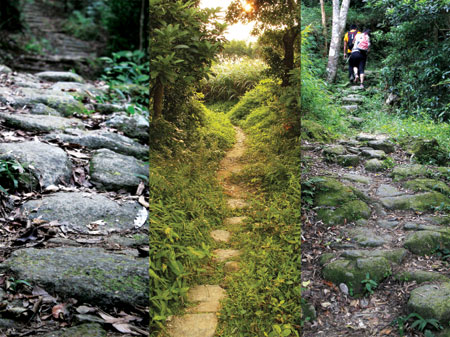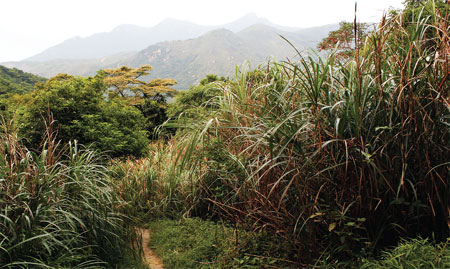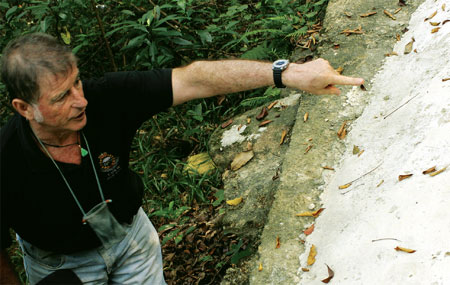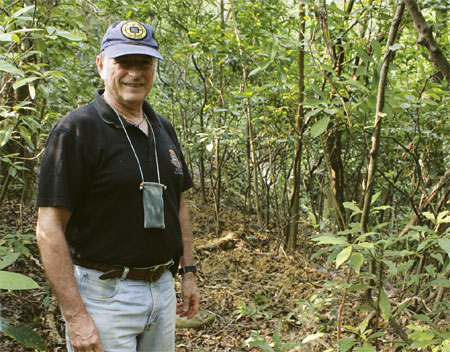Trekking ancient pathways
Updated: 2012-10-11 07:09
By Doug Meigs(HK Edition)
|
|||||||||
|
Ancient boulder walking paths in the New Territories date back hundreds of years, long before Hong Kong became a British colony. The paths once connected regional villages and market towns directly to northern urban settlements such as Guangzhou, the central city of Guangdong Province. Photos by Doug Meigs / China Daily |
|
Fa Sam Hang Village is located near a bus terminus, but its only access route used to be a boulder walking path. |
The govt is paying nearly HK$1 million for research of New Territories' ancient boulder trails. An advocate for trail preservation says the project is a step in the right direction, but at needless cost to taxpayers. Doug Meigs reports.
Guy Shirra was shocked and disappointed. After years of exploring Hong Kong's ancient boulder trails, tirelessly petitioning government departments to preserve the footpaths, and personally excavating some forgotten tracks, Shirra received a bittersweet e-mail from the Antiquities and Monuments Office (AMO) in July.
The AMO had hired a private consultant to duplicate much of his own work. Adding insult to injury, Shirra didn't learn of the government's plan, until nearly two years after official procedures had excluded him from making an alternative proposal. An AMO representative said that Shirra just wasn't qualified, based on "established government procedures."
"Why hadn't they been in touch with me? Because the stimulus for them doing (this consultation) was me," he says. "Although I welcome the fact that they've started to do something, I think that the way they've gone about doing this is appalling."
Shirra is speaking from Sai Kung's town center, on the patio of a pub near where the British expat lives, in a renovated village house with his Chinese wife and two dogs. Dressed casually in a black polo shirt tucked into jean shorts, the 65-year-old Shirra looks ready for a day of light hiking.
Old trails of unknown antiquity connect Sai Kung with an ancient network of boulder trackways, which once provided the sole thoroughfare between Hong Kong's disconnected villages and market towns. Before British warships and engineers arrived, the footpaths seamlessly had connected the pre-colonial region with the rest of Guangdong Province. Some routes led directly to the central city Guangzhou.
Hong Kong's ancient trails have, over time, been supplemented by newer hiking trails and paved roads. Motor vehicle roads are a relatively recent addition to Sai Kung and other parts of New Territories, and frequent pedestrian traffic from hikers and rural villagers has continued on the old paths.
Shirra observed the transformation of transport in the region during a 30-year career with Hong Kong's police force. He used to patrol Sai Kung regularly on foot, relying on the trails made of carefully arranged boulders and stones.
"From 1971 to 1973, I was in charge of a unit called the village patrol unit. It covered villages in New Territories and Sai Kung. We would send out four-man patrols, for four or two days at a time, and we would patrol all the remote villages. In those days, there were no roads. For example, the road to Sai Kung ended here," he says, gesturing towards the packed road full of minibuses and holiday-seekers heading northwards on the road to Wong Shek Pier.
A helicopter or boat might have dropped Shirra's unit in the northeast at villages now displaced by reservoirs. They would've walked back, visiting settlements along the way, gathering tips on illegal activities, while trying to satisfy villagers' requests for amenities, telephone lines, and shooting of wild boars.
The old boulder track would eventually lead them to Kowloon Walled City, an infamous no-man's land, from which the boulder trail emanated. The site had been a Qing Dynasty magistracy and military fort before the conclusion of the Opium Wars. A multi-storied slum had emerged above the site and existed outside of colonial jurisdiction (until its demolition was completed in 1994) - which is now a family-friendly public park.
Shirra first moved to Hong Kong amid the city's riots in 1967. He had taken a probationary police inspector's job after one year of teaching in Borneo. He quickly grew attached to the city. When he retired from the police force in 1997, he tried relocating to his native Britain where some of his grandchildren are living, but he felt like an alien. Shirra returned to Hong Kong, and resettled in Sai Kung in 2006, where he had always fancied taking up residence, surrounded by the ocean coast, clean air and ample access to hiking trails.
Although technically retired, Shirra has devoted himself to monitoring illegal development works and community complaints, via his administrative roles with the organization, Friends of Sai Kung. Aside from community service, he is also an avid trail runner with the Hash House Harriers, a Sai Kung social running club that he described as a "drinking club with a running problem."
|
The paths generally cross directly between settlements. New roads for vehicles generally followed geographical contours, allowing many of the remote, old trails to escape destruction. |
His passion for trail running quickly reacquainted Shirra with the boulder trails. He began developing a newfound interest in their largely undocumented history. As a youthful police officer, his appreciation for the trails was purely pragmatic. They were direct and he used them a lot. But relocating to the neighborhood exposed Shirra to mounting threats to the trails' existence.
Illegal village construction works alter trail settings, government's well-intentioned concrete paving works cover the more heavily trafficked boulder paths (which Shirra says destroys their historical integrity), while the encroachment of weeds and trees has reclaimed smaller, neglected tracks.
Shirra began researching. He contacted a prominent New Territories scholar, Patrick Hase (author and longtime British expat), who suggested he review British survey maps from 1903 that noted prominent Chinese trackways throughout Hong Kong. The amateur historian followed Hase's advice.
"I then discovered that the Hong Kong Archaeological Society had done this survey at the request of what was then called the Urban Council. They had come up with what were nine of the most important boulder trails - to which the AMO added to make a total of 14 (by 1986) - and (the Society) strongly recommended that a full survey be done and the best examples of these trails be given protection under the ordinance, but absolutely nothing was done about it," he says.
|
Retired police officer Guy Shirra points at the old boulders buried under concrete. The government and a nearby villager had added subsequent layers of concrete over the old pathway. |
|
Guy Shirra has dedicated the past six years to petitioning government departments to preserve New Territories' ancient boulder trackways. |
Shirra wrote a few trail guides to Sai Kung's boulder pathways, and he uploaded the files with photos on a Google sites page titled, "Hong Kong Boulder Trackways". He has also tried to convince the Sai Kung District Council to make one of the paths a pilot project for protecting similar paths around Hong Kong - to no avail.
In March 2009, he presented to the AMO some research he had uncovered, along with the old British survey maps, which Shirra says the AMO "had never seen or heard of". Then in June 2010, the Antiquities Advisory Board invited Shirra as an observer, while Lee Hoi-yin (Director of the University of Hong Kong's, Architectural Conservation Program) presented Shirra's proposal for protecting boulder trails.
He recalls the Board's positive feedback: "They more or less said they agreed, that 'we'd tag (the project) on, after we finish grading the 1,440-odd buildings (then being graded), and we'll call you up to give a presentation.'"
Giddy with optimism, Shirra put together a PowerPoint presentation, which he showed to the Friends of Sai Kung, and he waited for a possible opportunity to present his plan to the AMO. Growing impatient, he contacted the office this summer. Then came his big surprise.
The AMO had contracted Environmental Resources Management (ERM), a global consultancy firm, with offices in Hong Kong, in January 2011, to "assess the values and cultural significance of old trails in Hong Kong and identify issues involved in preservation and public enjoyment of these trails".
Shirra's passion and investigative diligence wasn't enough. He was furious. A representative from the AMO told China Daily that he lacks sufficient professional or academic qualifications to have been invited to submit a consultation proposal.
"Established government procedures in commissioning this sort of research consultation involve engaging relevant service providers by invitation of quotations. AMO had invited 11 relevant consultant companies to submit quotations in relation to the study. The company which made the lowest offer and compiles with the quotation requirements was selected," the AMO wrote in an e-mail reply to China Daily.
The e-mail continued: "field inspections and interviews with experienced local hikers and researchers, including Guy Shirra, are being conducted by ERM to gather the relevant information about the old trails in Hong Kong." The study is tentatively scheduled for completion in 2013, and the Antiquities Advisory board will deliberate its findings and recommendations upon completion. The ERM consultation team consists of a historian, conservation architect, cultural heritage specialist and land surveyor.
Hase, who pointed Shirra towards the old survey maps, was responsible for providing ERM's historical background on the 14 primary boulder trackways. He has already submitted his research to the AMO, and the office rejected China Daily's requests to review the document.
Although Shirra feels miffed about the outcome, he's trying to make the best of the situation. He still is trying to help ensure the boulder trackways acquire some form of heritage protection. Much as he did with the AMO years before, he contacted ERM to introduce himself and raise some of his concerns for Sai Kung's ancient trails. Staff from the firm made a site visit with Shirra recently, and he says they are planning another visit in November.
Hase credited Shirra's petitions with triggering the government's call to action. The retired civil servant has been researching New Territories life and history for the past 30 years. His primary interest in ancient boulder trails is their hierarchy of historical importance.
"They are the original arteries of trade and movement in the New Territories. There was a lot of trade carried along with them, and the more they are concreted, the more they are indistinguishable from the new paths built by the country parks authority that have no historical significance, it becomes difficult to tell one from another," he says during a phone interview.
Hase says many of the main walking paths have been buried under concrete, in parts. Yet they often escaped destruction since newer British vehicular roads followed geographical contours rather than directly crossing rugged terrain. Smaller trails are among the best preserved but of lesser historical significance, though they are in constant danger of being obliterated by tree roots and other foliage overgrowth.
He excuses much of the government's laying concrete over the trails for safety reasons. "As a former government officer, I can see the problem, of needing to cover yourself against liability claims for negligence. (The boulders) are treacherous," he says, worrying that long periods of moisture can encourage slippery moss growth, which could result in an injured hiker suing the Country Parks Authority. Hase previously served as District Officer of Shatin and held other government positions.
Shirra expresses a more strict view on mixing concrete and boulder trails. He doesn't approve. He invites China Daily to inspect one granite bridge of Wo Liu Village, north of Sai Kung town.
After hiking into a picturesque thicket, he points to where the government had layered concrete over a boulder path that led toward a few renovated village houses at Wo Liu. A resident had further widened the path with aditional concrete to transport building equipment for house renovations. An old granite panel bridge crosses a meandering stream in the heart of the woods. The bridge also suffered irreversible damage, smothered under a concrete expansion and a railing add-on.
"This sort of thing shouldn't go up," he says, disgusted at what he regards to be vandalism of Hong Kong's heritage. "I've been here on site visits with the Lands Department. They said that yes, it's very unfortunate, and all of it normally should have been removed. But they were worried about damaging the granite."
(HK Edition 10/11/2012 page4)




